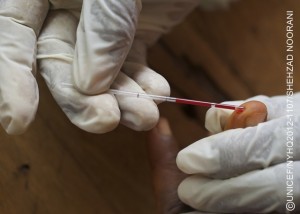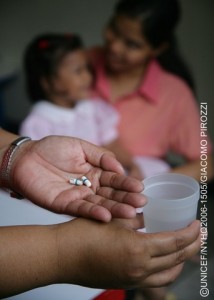UNAIDS and UNICEF welcome news of a baby born with HIV who now as a toddler appears “functionally cured” through treatment And looks forward to further studies to see if findings can be replicated
2013-03-04
GENEVA/ HONG KONG, 4 March 2013 — The Joint United Nations Programme on HIV/AIDS (UNAIDS) and UNICEF welcome a new case study, which found a baby treated with antiretroviral drugs in the first 30 hours of life and who continued on HIV treatment for 18 months appeared to be functionally cured.

![Madina, 9, [NAME CHANGED], who is HIV-positive, paints at the UNICEF-supported Kaldirgoch Day Care Centre, in the city of Tashkent, the capital. The centres provide psychosocial care, medical and legal counselling and an environment free of stigma and discrimination to children with HIV/AIDS and their families. Madina is participating in art therapy, which encourages children to express themselves and to connect with others. [#3 IN SEQUENCE OF THREE] In July 2011 in Uzbekistan, UNICEF is working closely with the Government to improve conditions for children, particularly in the areas of health and education. While child mortality rates have decreased significantly, some 20,000 under-5 children still die each year. Further, more than 10 per cent of eligible primary school children do not attend school. In addition to programme and advocacy support, UNICEF is currently running a Multiple Indicator Cluster Survey (MICS) in the country. This is part of the fourth round of MICS, scheduled for 2009 2011, that is helping countries measure their progress in achieving national and international child survival and development goals, including the United Nations Millennium Development Goals (targeted for achievement in 2015). MICS data is collected in face-to-face interviews in nationally representative samples of households, generating one of the worlds largest sources of statistical information on children and women. Since the mid-1990s, MICS have enabled more than 100 countries to produce statistically sound and internationally comparable estimates of a range of health, education, child protection and other indicators.](/wp-content/uploads/2015/12/20130304_hivbaby_1-300x214.jpg)
The findings were presented today at the Conference on Retroviruses and Opportunistic Infections (CROI) in Atlanta, Georgia in the United States of America.
 According to researchers the mother who was living with HIV at the time of birth had not received antiretroviral (ARV) medication or prenatal care. Researchers say that the child was born prematurely in July 2010 in the state of Mississippi. Due to the high risk of exposure to HIV, the researchers say the baby was started on a triple therapy regimen of antiretroviral drug 30 hours after birth and before proof of infection could be confirmed. The newborn’s HIV-positive status was subsequently confirmed through a highly sensitive polymerase chain reaction testing which was conducted on several occasions.
According to researchers the mother who was living with HIV at the time of birth had not received antiretroviral (ARV) medication or prenatal care. Researchers say that the child was born prematurely in July 2010 in the state of Mississippi. Due to the high risk of exposure to HIV, the researchers say the baby was started on a triple therapy regimen of antiretroviral drug 30 hours after birth and before proof of infection could be confirmed. The newborn’s HIV-positive status was subsequently confirmed through a highly sensitive polymerase chain reaction testing which was conducted on several occasions.
The case study stated that the baby was discharged from the hospital after one week and continued ARV treatment until 18 months of age, when for reasons that are unclear the treatment was discontinued. However, when the child was seen by medical professionals about a half a year later, blood samples revealed undetectable HIV levels and no HIV-specific antibodies.
If the findings are confirmed this would be the first well-documented case of an HIV-positive child who appears to have no detectable levels of the virus despite stopping HIV treatment.


“This news gives us great hope that a cure for HIV in children is possible and could ing us one step closer to an AIDS free generation,” said UNAIDS Executive Director Michel Sidibé. “This also underscores the need for research and innovation especially in the area of early diagnostics.”
In 2011, UNAIDS and its partners launched a Global plan for the elimination of new HIV infections among children by 2015 and keeping their mothers alive. Significant progress has been made and continued support and research is needed.
 “While we wait for these results to be confirmed with further research, it is potentially great news,” said UNICEF Executive Director, Anthony Lake. “This case also demonstrates what we already know—it is vital to test newborn babies at risk as soon as possible.”
“While we wait for these results to be confirmed with further research, it is potentially great news,” said UNICEF Executive Director, Anthony Lake. “This case also demonstrates what we already know—it is vital to test newborn babies at risk as soon as possible.”
According to data from the World Health Organization and UNICEF only 28 per cent of HIV-exposed babies were tested for HIV within six weeks of birth in 2010. Obstacles to early diagnosis and treatment include the high cost of diagnostics and difficulty of getting timely results and limited access to services and medicines. There were 330,000 children newly infected with HIV in 2011. At the end of 2011, 28 per cent of children under the age of 15 living with HIV were on HIV treatment, compared to 54 per cent of eligible adults.
Now two and a half year’s old, the toddler continues to thrive without antiretroviral therapy and has no identifiable levels of HIV. However, UNAIDS cautions that more studies need to be conducted to understand the outcomes and whether the current findings can be replicated.









